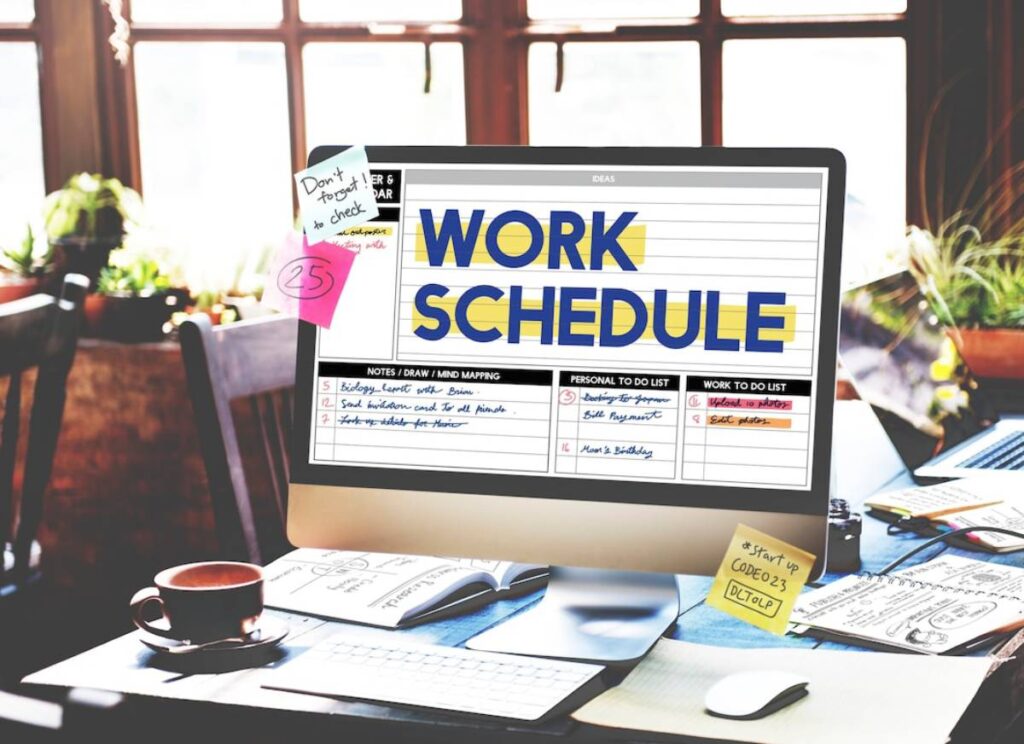The Business Blog

Time Blocking Techniques for Remote Professionals: Mastering Productivity in Remote Work
In the changing world of remote work, professionals want to boost productivity and keep a healthy work-life balance. One effective strategy is time blocking. This method organises tasks. It helps remote workers focus on what matters. They can work without distractions. In this guide, we explore time blocking. We’ll cover its benefits and share tips for using it in your remote work schedule.
Time blocking is planning your day. You assign specific hours to different tasks. Unlike a to-do list, time blocking gives you a structured schedule. This helps you manage your time better and with more intent. It’s especially useful for remote workers. They often deal with distractions at home, inconsistent routines, and little supervision.
Key Benefits of Time Blocking for Remote Professionals
Time blocking helps remote workers manage multiple tasks while at home. Setting specific times for each task can help people be more productive and efficient. Here are some key benefits of time blocking:
Enhanced Focus and Concentration

One of the main benefits of time blocking is that it helps remote workers focus. By reserving a specific time for each task, they can dive deep into their work. This leads to better quality and quicker completion.
Reserving time helps avoid distractions like checking emails or scrolling social media. When you know when you’ll do these tasks, it cuts down on impulsive actions and boosts focus. It also lessens decision fatigue because time blocks eliminate the need to ask, “What’s next?”
Improved Work-Life Balance
Remote work often blurs the boundaries between professional and personal life. Time blocking creates a clear remote work schedule. It separates work hours from personal time. This approach helps promote a healthier work-life balance.
When remote workers create clear time blocks for work and personal tasks, they can relax after hours. This boundary helps reduce stress. It keeps work from intruding on family or leisure time. Also, making time for personal care, exercise, meals, and relaxation helps us focus on what matters.
Reduction in Procrastination
Having a clear plan for the day makes remote professionals less likely to procrastinate. Time blocking acts like a roadmap. It keeps people focused on their tasks and reduces procrastination for meaningful work.
When tasks have clear start and end times, there’s less confusion. This also helps motivate people to begin on time. The visual structure gives a feeling of urgency and progress. This can help increase motivation. Setting aside time for recurring tasks helps create steady habits. This cuts down on the mental push needed to begin them.
Increased Accountability
Time-blocking tasks make it easier to track progress and stay accountable. This method helps meet deadlines and reach goals on time.
Time blocking serves as a self-check mechanism. At the end of the day, look at your blocked schedule. Compare it to what you accomplished. This helps you see where changes might be needed. It also builds a feedback loop that helps fine-tune task duration estimates.
Flexibility and Adaptability
While time blocking provides structure, it also allows for flexibility. Remote workers can change their schedules easily. They can handle unexpected tasks or shifting priorities. This way, they stay focused on their main goals.
This adaptability makes time-blocking a resilient productivity method. For example, if a meeting is rescheduled or an urgent task appears, professionals can change their blocks. This way, they make sure nothing important is missed. Having a visual layout of your time allows for smarter, quicker changes.
Additional Expert Tips & Common Mistakes to Avoid
Implementing time blocking effectively requires more than just segmenting your day into chunks. Here are some expert tips and common pitfalls to avoid:
Start with a Clear Plan
Before you begin time blocking, take some time to outline your goals and priorities. Identify the tasks that are most critical and require your utmost attention. This clarity will help you allocate your time more effectively.
Try grouping your tasks, like deep work, meetings, emails, and breaks. You can also add colour codes to your calendar for easy reference. This visual strategy makes it easier to identify where most of your time is invested. Daily or weekly planning sessions help you find your top priorities. Then, you can align them with your time blocks.
Be Realistic with Your Time Allocation
One common mistake is overestimating the time available in a day. Be realistic about how long each task will take, and avoid cramming too many activities into a single day. This will prevent burnout and ensure you can maintain a consistent pace.
Factor in transition time between blocks and anticipate delays. It’s better to slightly overestimate than to constantly run behind schedule. Avoid perfectionism when planning; the goal is to build structure, not rigidity.
Include Breaks and Buffer Time

Don’t forget to schedule breaks and buffer time between tasks. This helps prevent fatigue and gives a cushion for overruns or surprises.
Short breaks, such as a 5-minute walk or a 10-minute coffee break, can rejuvenate your focus. You can place larger buffer blocks during the day or later to manage overflow or emergencies. Be mindful of cognitive energy—your brain needs rest to perform at its best.
Review and Adjust Regularly
Your time-blocking schedule should be dynamic. Regularly review your progress and adjust your blocks as necessary. Being adaptable will keep you aligned with your goals. It also helps you make the most of your remote work schedule.
Take time each week, maybe Friday afternoon or Sunday evening, to think about what worked and what didn’t. Also, consider how to improve your time blocks for next week. Use this review to identify recurring distractions or energy dips that need attention.
Avoid Multitasking
It can be tempting to multitask, especially when you’re working from home. But it often ends up being counterproductive. Focus on one task at a time during each block to maximise efficiency and minimise errors.
Single-tasking allows for deeper focus and reduces mental fatigue. Switching tasks often can harm one’s thinking and slow down progress. Deep work, in particular, requires sustained attention.
Advanced Insights and Expert Recommendations
To truly master time blocking, remote professionals can incorporate advanced strategies and insights:
Leverage Technology and Tools
Utilise digital tools and apps designed for time blocking and task management. Tools like Google Calendar, Trello, and Asana help you organise your schedule. They also give reminders to keep you on track.
Other notable tools include Notion, Clockify, and Todoist. Integration features help sync devices and teams. This is great for remote teams that work together on schedules. Consider using automation tools like Zapier to streamline task updates between platforms.
Customise Your Blocks
Recognise that different tasks require different levels of energy and focus. Customise your time blocks based on the nature of the task. For example, use high-energy times for complex tasks. Save low-energy periods for routine activities.
Many people focus best in the morning. In the afternoon, they often struggle. Use this knowledge from chronobiology to your advantage. Understanding your personal productivity rhythm can help in designing smarter blocks. Also, differentiate between shallow and deep work in your planning.
Experiment with Different Techniques
Time blocking is not a one-size-fits-all solution. Try different methods like the Pomodoro Technique or the 52/17 Rule. See which one suits you best. These methods can complement time blocking by enhancing focus and productivity.
The Pomodoro technique is simple. Work for 25 minutes, then take a 5-minute break. This method works well for repetitive tasks. The 52/17 Rule suggests 52 minutes of work followed by a 17-minute break, ideal for intensive tasks: test variations and note which yield the most consistent results.
Seek Feedback and Support

Engage with peers or mentors to gain insights into how they manage their time. Sharing experiences and strategies can give you fresh ideas. This helps you improve your time-blocking method.
Accountability partners can help keep you on track. Think about joining a remote productivity group. You could also set up co-working sessions. In these, everyone sticks to their own time-blocked schedule. Talking about your goals adds a layer of external motivation.
Conclusion: Mastering Time Blocking for Remote Work Success
Time blocking is a powerful tool for remote workers. It helps you manage your schedule and increase productivity. This guide offers strategies to create a work schedule that meets your goals. For time blocking to work well, you need to be steady, flexible, and willing to make changes.
Start your time-blocking journey with this key idea: the goal is balance. You want a fulfilling work-life experience. So, why not start today? Start mastering your remote work schedule. Unlock your full potential as a remote professional.









